Category: Photography
Deal or no deal? European Travel post-Brexit

With the end of March approaching fast and the UK still surrounded by uncertainty around its impending exit from the European Union, anyone planning European travel might, rightly so, be a little worried about changes to come. Our partners at Responsible Travel have put together a few very useful pointers around what is likely to be in place post-Brexit – deal or no deal:

- UK-EU flights will operate – the European Commission has confirmed UK airlines can fly to the EU. A cap on the number of flights based on 2018 levels is being contested
- Ferry services and cruises from the UK will sail – shipping rules are mostly international
- UK passport-holders won’t need visas for the EU – an electronic visa-waiver scheme for the Schengen area is due in 2021 but would happen anyway and is nothing to do with Brexit
- Passports must be valid for six months from arrival date. Here’s a useful link which will help you determine if you need a new passport – https://www.passport.service.gov.uk/check-a-passport
- If you are buying a package trip from the UK you will continue to enjoy full financial protection thanks to the EU Package Travel Directive. The UK has adopted the same level of protection and this has been written into UK law. This may help you determine what a package holiday actually is – https://www.abta.com/help-and-complaints/frequently-asked-questions/what-package-holiday
- The European Health Insurance Card (EHIC) won’t be valid in the event of no deal. We always recommend that you have adequate travel insurance in place. It is also a good idea to buy your trip with a credit card as this will give you an added level of insurance and it is now illegal to charge you more for paying by credit card.
- UK drivers in the EU will need an International Driving Permit – available from the Post Office for £5.50
- Pets will still be able to travel, but owners should consult a vet in advance about documents and health checks.
Beautiful Wedding Photography: Planning, Respect, Light and Imagination!

We were extremely honoured to photograph the wedding of Lukas and Natalie at the oldest church in London, the stunning Temple Church, followed by reception at the exquisite Reform Club on Pall Mall.


The couple decided to have a few posed photos and we spent some time together about a month before the wedding to visit both venues, then we exchanged ideas and images to determine what their favourite style was, so we could cater to their taste and meet their expectations. We contributed ideas of our own and started planning the shots.
We are strong believers that the style of wedding photography should be dictated by the couple and not the photographer, and a good photographer should be able to meet any style requirements and expectations as needed, which during a wedding will vary throughout the day. A good photographer should contribute creative ideas and input based on experience, but not try to impose their style on their clients.
A lot of people these days say they don’t want too many posed photographs because they fear they will spend too long during the photo shoot instead of being with their family and friends and we couldn’t agree more that they should spend more time enjoying their wedding day! In this instance the couple, family, bridesmaids and groomsmen only spent a total of just over an hour on posed photos resulting in no less than 30 studio-quality images, with a maximum of 1-2 minutes spent effectively posing for each image. This is thanks to us, the wedding photographers, spending a good couple of hours beforehand setting the lights, arranging the furniture as needed and preparing for the images we had already planned in our heads!
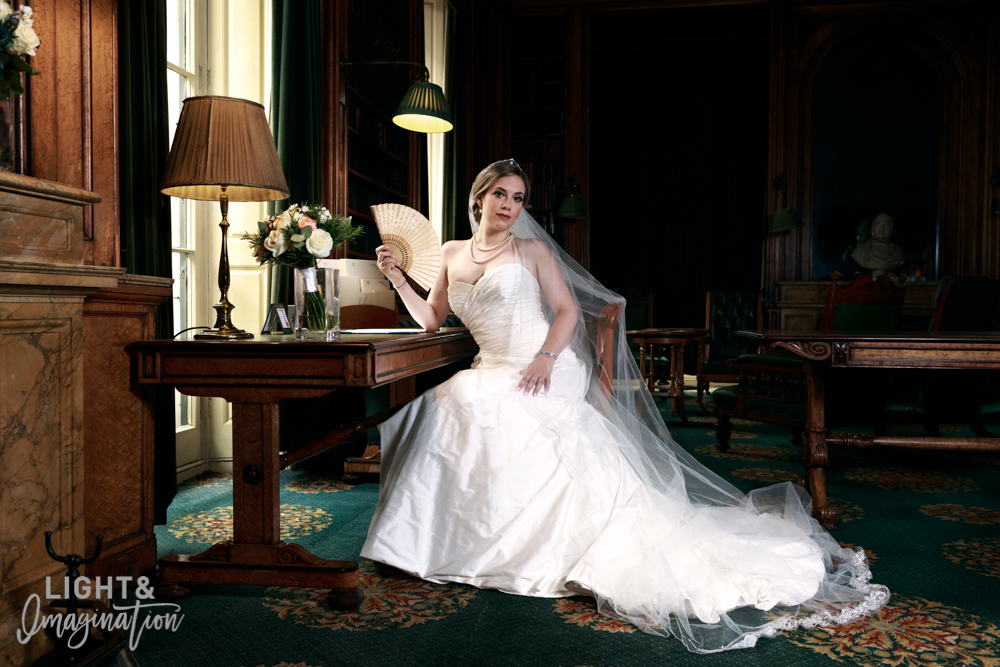

The great thing about being a well-rounded professional photographer is that you take inspiration from anywhere and ensure that wedding photos are as creative as fashion shoots, and not stuck in traditional ‘wedding poses’. Andreea is a big fan of Annie Leibovitz’s work especially her female fashion group portraits and she also likes asymmetric poses that challenge the status quo when it comes to wedding photography. The key is to work with the clients’ style and requirements, the environment available, and add your own creative touches and ideas to create beautiful images. The Library at the Reform Club was a fabulous setting for both bridesmaids and groomsmen group photos. More importantly, we had fun working on these, and both the girls and the boys enjoyed taking part of this and just naturally fell into place as if they’d been professional models for a long time!
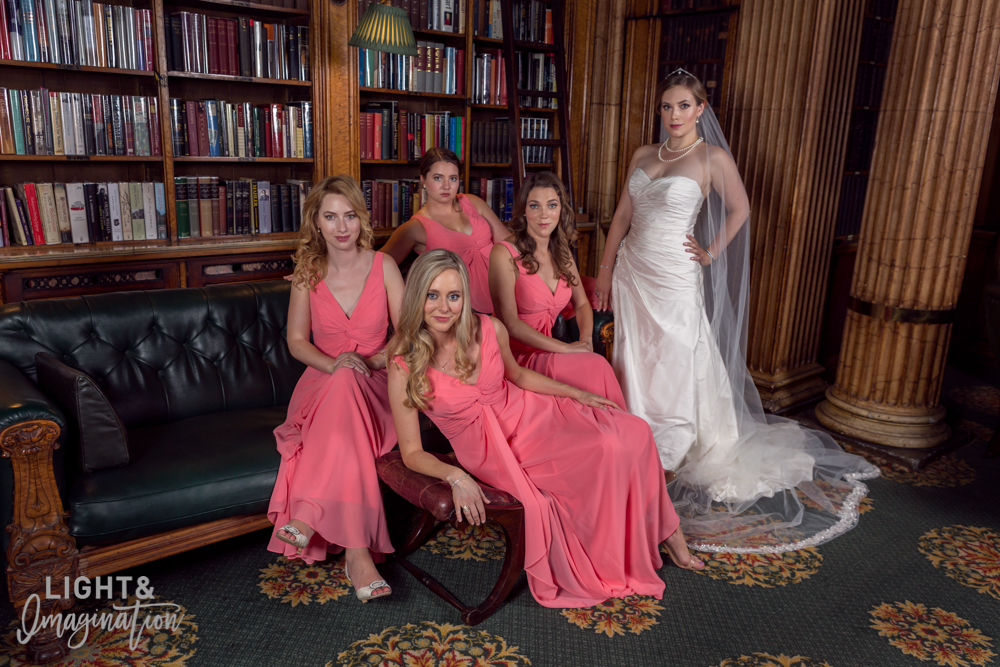
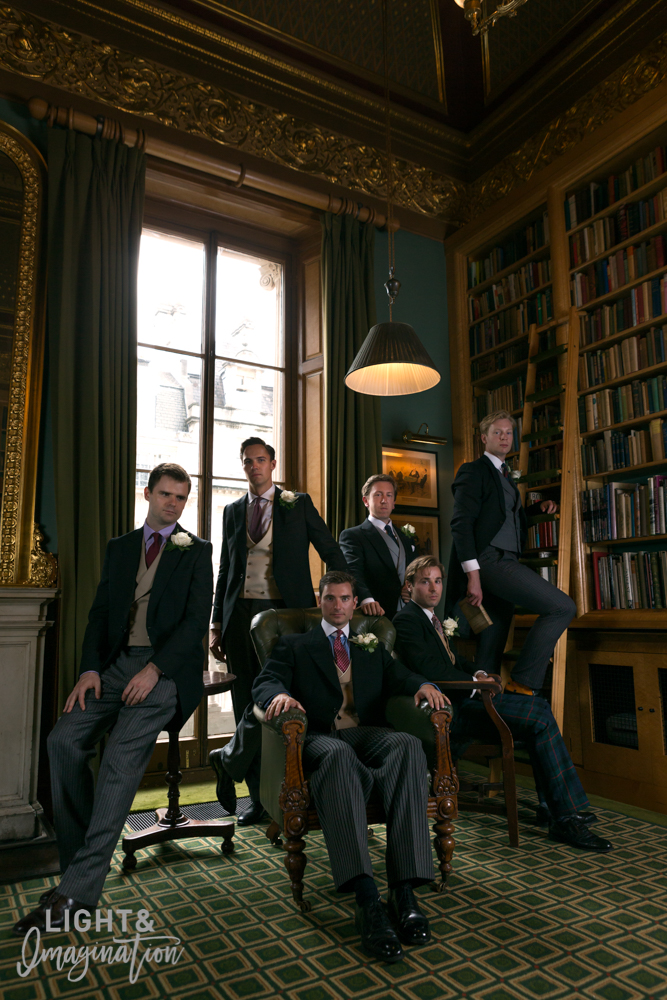
Stairs are your friend! Again, the Reform Club afforded such a fantastic backdrop to these family and bridal photos. Lighting however is paramount so that it brings out the details required, ensures people and clothing and architectural details are nicely lit but preserves a moody atmosphere to match the spirit of the place and occasion. When working with mirrors and reflective surfaces – as well as guests wearing glasses, obviously a big challenge is reflections – our big soft box was carefully positioned so it provided just the right quantity, quality and direction of light for these shots. Again, the subjects were only required to spend a maximum of 2 minutes posing, as we had everything planned, pre-tested and ready to go when they arrived.

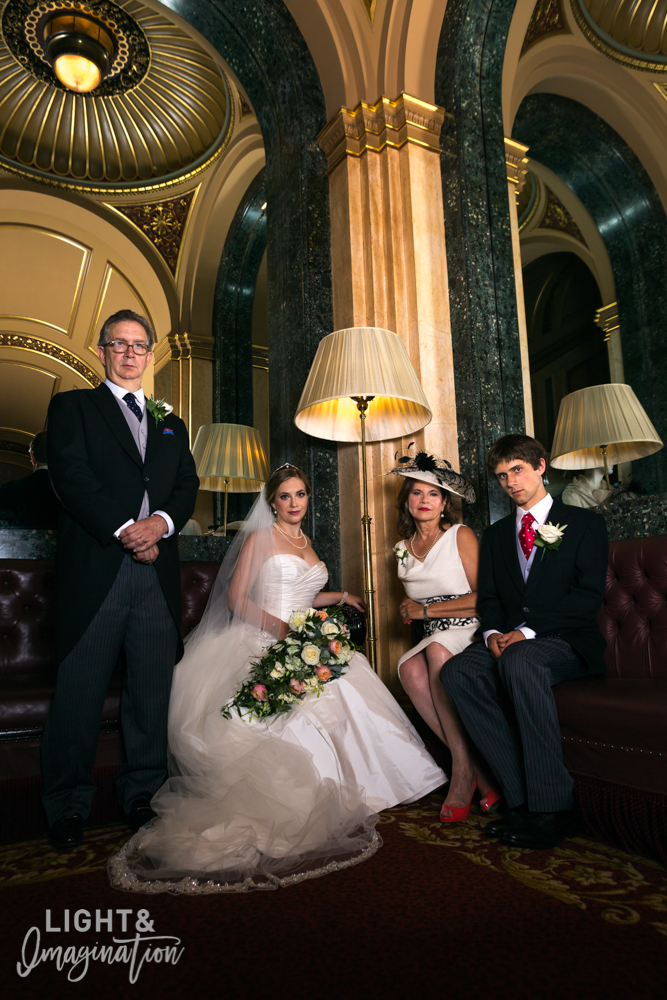

Our couple chose to have the posed photos before the actual ceremony and reception, so they were all ‘out of the way’ before the wedding day started in the earnest! After finishing the posed session, we left for Temple Church with plenty of time to ensure we were there before the bride arrived. This allowed us to capture a few images of the beautiful setting in the church, as well as play with the opportunities afforded by the rainy day. When the bride arrived, Andreea was waiting outside to capture her arriving, while Matt was inside the church capturing the anticipating groom. The benefit of having two photographers on the day, which is what we at Light and Imagination wedding photography offer as standard, is being able to be in two places at once! The classic example is groom waiting being captured at the same time with the bride walking down the isle.




Being inconspicuous and respectful during the actual ceremony is paramount. We always attend the church rehearsal when there is one planned, in this case the day before the wedding. Being there allowed us to re-connect with the bride and groom, meet immediate family and friends and importantly speak to the vicar and ensure any restrictions are taking into consideration. Obviously while there we also took a few test shots and planned where we were going to stand, what settings we are likely to require and so on. We always have the cameras on silent and use zoom lenses as needed to ensure we capture detail without having to be in people’s faces. We also aim to capture everything with natural light only, as flash lighting can be disruptive and is very often – understandably – not welcome by the guests or the vicar. With two photographers we are able to capture a variety of angles and moments, which is essential as the wedding ceremony will go faster than you think and there’s no chance for a repeat! As a photographer, knowing how to make the most of your equipment is crucial, you will be required to change settings and lenses probably a few times throughout – a fast response and nerves of steel are also required. Don’t miss essential moments by reviewing your photos or changing your lens at the wrong time! Practice makes perfect, but also having two photographers on the day minimises the chance of any omissions or mistakes.



Variety is the spice of life, right? We really wanted a photo of the bride and groom in front of the astonishing church door, after the ceremony, and we decided a different lighting set up was right to provide a little variety. A small ‘film-noir’-inspired selection resulted, very cinematographic and just a little different. We also used the opportunity to deliver another quick family photo with members who weren’t at the shoot earlier in the day. Again, very little time was spent here so we could allow the guests to make it to the champagne reception as soon as possible!

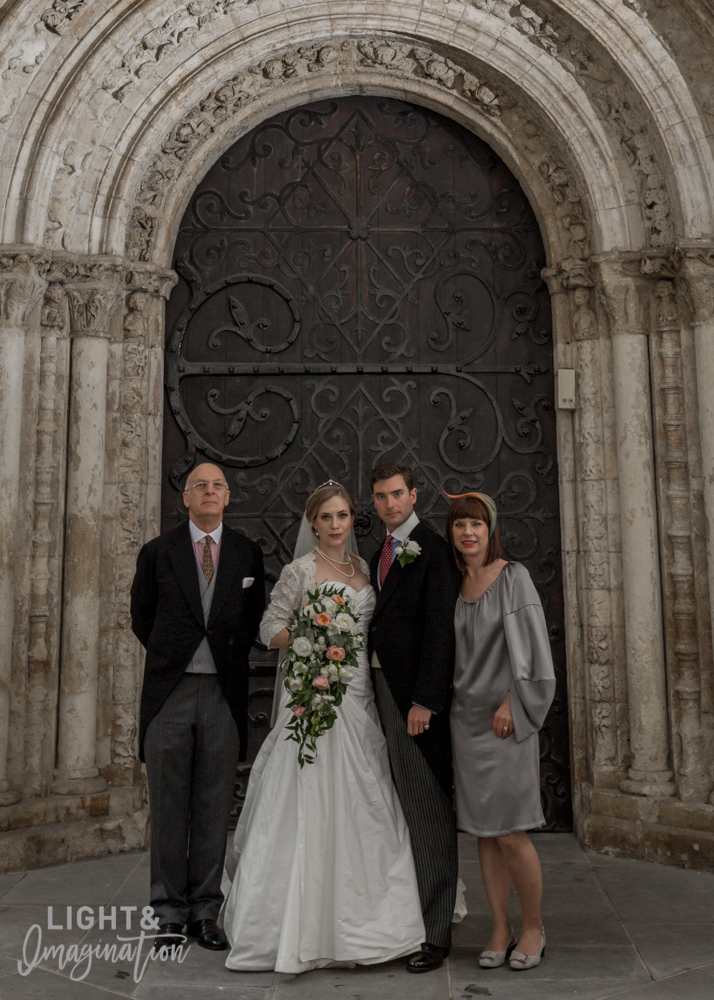
Capturing moments and emotions is, of course, essential, and about 80% of our photographs throughout the day are entirely candid (call it documentary, journalistic, candid, un-posed, there are many different ways to describe this type of photography). Candid is not happy snapping though, which is where a lot of wedding photographers fail, it still requires anticipation of the moment, consideration of lighting, composition and respect for your subject! We see too many photos emerge that don’t do their subjects justice at all, because the photographer is too self-indulgent in their ‘documentary’ ambition or the processing has been done so badly (often to rescue a badly-taken photo to begin with). Oh, and we never ever photograph people while eating! Who would want that?


Scottish reeling followed dinner and we got a little creative with the angle and style, capturing motion of this fast-paced and super fun part of the evening! When it came to the first dance, we were prepared to make the most of our captures while ensuring there was sufficient lighting to bring out the relevant details but maintain a moody atmosphere. Matt was in charge of creating the soft lighting from afar (entirely inconspicuous to the dancers) while Andreea captured the images from the side of the dance floor.


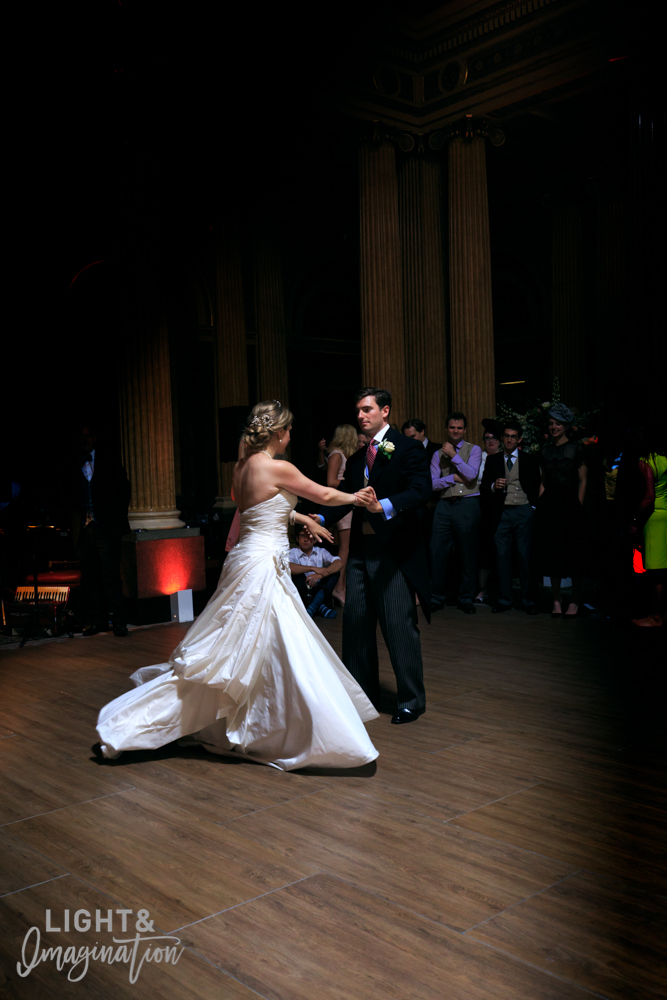
Last but not least, capturing details from the day is important to remind the couple of the beautiful setting, venue, and decorations they spent time and money to design and organise. We usually capture these images just before the wedding breakfast, when everything is nicely arranged and ready for guests.


Wedding photography is, without a shadow of doubt, one of the most complex (technically and creatively) but also one of the most rewarding types of photography. It requires the photographers to be technically sound, have intimate knowledge of lighting and composition, to be personable and create a good rapport with their subjects, to be there, in the moment, but inconspicuous at the same time, to have a huge amount of responsibility and respect for everyone and everything concerned, and to have stamina and be able to work hard for sometimes up to 14 hours on the day, with few breaks in between.
Brides and grooms to be, if you like what you see in this blog post, get in touch to see if we are who you’re looking for when it comes to wedding photography for your big day! CONTACT US
Fellow photographers, we love nothing more than sharing the knowledge, so if you think you can learn from us, check out our training courses and get in touch if you’re interested PHOTOGRAPHY TRAINING COURSES
The name is Stoddart. John Stoddart.

The name is Stoddart. John Stoddart.
From Liverpool to Whitstable via Hollywood, a lifetime of images.
24th June – 9th July 2017 @ Light and Imagination Whitstable 82 High Street

We’re marching full speed ahead on our journey of becoming THE photography gallery of choice in the east of Kent. We are over the moon to announce that we’ve teamed up with world-famous celebrity photographer John STODDART for a number of joint projects.
The first one will be a solo exhibition for John’s reportage, celebrity and risqué images. This will show between 24th June and 9th July 2017.
We recently interviewed John in his Whitstable pad. Walking into John’s stylish yet unpretentious, homely living room, we can’t help but remark on how coordinated he is with his environment.
‘Sometimes I feel like I’m living inside my pictures’, he laughs.

Q: Where are your roots and how did they influence your photographic journey?
‘I was born in Liverpool and I’d taken photographs for as long as I can remember. Long before social media, if people had something to say, they would take it to the streets back then! Everywhere was a photograph to be had.’

Q: Was there a breakthrough into getting published as a photographer?
I’d taken some photographs for the hairdresser salon my girlfriend worked in, which got published, and I got noticed. The big breakthrough came with Frankie Goes to Hollywood. They were friends of mine and I was helping them get their record together! I did a big shoot for them and one of the images, quite controversial, got published in the NME – the Holy Grail of music publications at that time. I then started to do more work for the rock and roll press.’

Q: Who’s the nicest celebrity you’ve photographed?
‘Pierce Brosnan by a mile! He’s a charming man, so easy to photograph. He was such a happy guy because he got his dream job; James Bond in Golden Eye.‘

Q: What’s the sexiest part of a woman’s body?
‘Her legs I would say. I’ve always been a leg man’ (giggles).

Q: And a man?
‘Probably his face, I’m thinking now more of what a woman would think of that question. Because obviously women are so much more sophisticated when it comes to attraction.’

Q: Which photographers inspired you over time?
‘They tend to be non-British, people like Richard Avedon and William Klein. One guy I really loved was Weegee, the crime photographer in the 1930s. So mostly American with a few exceptions such as Guy Bourdin and of course Helmut Newton: he influenced everyone in my generation. I’d also always been interested in portrait and pin-up. I wanted to do portrait and fashion, but I’m not really into fashion.’
Q: But you are a very elegant man.
‘Yes I like to be smart, classic, but I’m not into fashion trends. I’d probably be wearing a pair of shorts right now otherwise.’

The name is Stoddart. John Stoddart
From Liverpool to Whitstable via Hollywood, a lifetime of images
will be showing between 24th June – 9th July at Light and Imagination, 82 High Street Whitstable, CT5 1AZ (www.lightandimagination.com)
RSVP: info@lightandimagination.com

China Photography Holiday launches at Largest Photography Show in Europe

For the first time in the UK, Light and Imagination launch Photography Tours in China – Avatar Mountains await!
Over the years, photographers Andreea and Matt, founders of Light and Imagination Photography have searched the world for the best off-the-beaten-track locations to offer unparalleled photography tour experiences. They are now ready to open their doors to keen photographers who want to experience real China in amazing, authentic and super photogenic settings.
A 10-day Photography tour is being launched at the NEC Photography Show 2017 with a special early-bird price, no single supplements and extra discounts for room sharers.
The first China Photography Tour will take place in May-June 2018 and cover two amazing locations ZhangJiaJie (film set for ‘Avatar’) and FengHuang (step-back-in-time ancient walled city and UNESCO heritage).
With a small group of maximum 10 participants, two UK professional photographers and one English-speaking local guide, this can be a photographic trip of a lifetime. The tour price includes all group and individual tuition and feedback, accommodation, meals, internal travel and entry fees.
For more information and booking enquiries please visit Light and Imagination on stand J35 at the NEC Photography Show between 18th-21st March 2017, contact Andreea on 07950481728 or Matt 07764167943, email info@lightandimagination.com or click here!
In 2017, what are you going to invest in to improve your photography?

If I told you that buying this lens, or that tripod or whatever piece of kit would you can think of would solve all of your photography issues and propel you instantly into taking the pictures that you always dreamed of, you would immediately rush out and buy it, right? I think a lot of people would…
So, new lens could possibly cost you £500 upwards. New camera body, this would easily set you back a £1000 or more. New tripod could possibly cost you £300. Most people would have no hesitation considering these investments into improving their hobby and results.
But if I told you to book yourself some training courses and learn to get the most out of the equipment you already have, all of a sudden, you can’t afford it? I am always surprised by this.
A little while ago, a chap was in the gallery browsing at the photographs we have for sale. He commented that our pictures are so sharp and that he needed a new camera to improve his pictures. I noticed that he had his camera with him and that he also had the kit lens on it, neither of which he seemed to think were any good. I asked him why he thought the camera and lens were no good, he told me that he wanted to achieve pictures like ours and that more “professional” kit was required to do that. I then asked him what his favorite picture was and he told me it was one of the nightscapes that we have here because it was so sharp and nicely done.
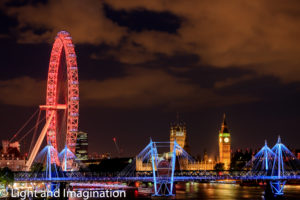
When I told him that this was shot on the exact same camera and lens that he had in his hand right then, he was amazed. I then took him around the gallery showing all the pictures that I took with his camera and lens combination. Well, to say he was surprised was an understatement. We have photos in the gallery taken on camera and kit lens worth no more than £100 (like the ‘Beach Hut Kids’ below).

There are many information resources nowadays and you think it should be enough to learn from others, websites, free YouTube tutorials, you can read books, you can talk to your friends, etc. But let’s be honest, there really isn’t any substitute for learning from a teacher. Did you leave school having learned everything from YouTube? Can you learn to play a musical instrument solely from online tutorials? Sure, you can try and you will probably achieve a certain degree of knowledge after countless time spent browsing and reading, provided you have conquered your analysis paralysis. But there is nothing like human interaction, feedback and learning by doing amongst likeminded peers. It will surprise you just how much faster you learn and improve from professional training.
Investing in training and learning is the best way to improve. Of course it is not an either/or situation. You will need to invest in the right equipment for your needs too. But learning and advice from more experienced professionals will guide you and help save you money by investing in the right equipment to suit your needs, rather than just buying things in the hope to improve. And then, all you need is lots and lots of practice. Nothing is an instant success.
So, learn how to use your kit and get out there and practice! Remember the best camera in the world is the one that you have with you. And never stop learning.
A New Photography Business in Whitstable Hoping to Capture Your Interest

We were recently featured in Whitstable Times for the opening of our Photography Gallery Studio & Training Facility in Whitstable. The following is the article:
“A new gallery and photography business has opened in Whitstable.
Light and Imagination in the High Street is providing product, wedding, event and corporate photography services. And from January next year, there will also be training courses for budding enthusiasts.
Owners Andreea Paciu and Matt Arnold, who share a passion for photography, are also exhibiting their work at the venue.
Ms Paciu of Regent Street said: “We both are photography enthusiasts and have pursued it as a hobby all our lives pretty much. We now are keen to share our skills with people of the town.”

The couple, who have invested £40,000 in the business, have diverse education and career backgrounds – philosophy, engineering, management consultancy and teaching.
But their common passion for photography brought them together five years ago. They travelled the world together clicking snaps, before deciding to put their passion at the core of their business.
And after having lived at several places including London, they made Whitstable their home three years ago after falling in love with the ‘ethos of the place’.
They now see a long-term future in the ‘lovely’ town.

Ms Paciu added: “It has a tight local community, lots of independent shops and businesses. And as a couple opening a business, we hope it’s the right thing for the town.”
The gallery will open from Friday to Sunday and the studio will be available throughout the week. And the couple are willing to travel across Kent and to London for work promising ‘original and creative’ pieces of work with every job they get.

The 41-year-old added: “Our want to deliver tailored photography services to clients. We have made an emotional and financial investment in it and are very optimistic about the future. We hope that our effort will be well received.”
The couple have put their images and print on display – costing between £60 to £490 – and are inviting people to drop in, have a look and give them their feedback.
She added: “We are in our first year of business and it would be really good to know what people really want.”
How to ensure clarity between you and your wedding photographer

We were recently featured in Bride Magazine with some of our tips for ensuring clarity between you and your wedding photographer. Here is the article:
Don’t be afraid to probe photographers in the search for your perfect match; here are some words of advice and question suggestions from photography company, Light and Imagination.
In this day and age, there is a very competitive professional photography landscape. This means a few things for you, the brides-and-grooms-to-be: the great deal of choice means that you can get good prices, but also you may quickly reach analysis paralysis.
On the other hand, you are within the target audience for numerous professional photographers or companies and sometimes the messages can be confusing or even misleading. In the flurry of information, can you read between the lines and decipher the PR and marketing code that you get bombarded with? Do you know what you will get for your money from your photographer?
Here are a few words of caution and tips to ensure you avoid disappointment and book the right photographer for your needs.

1. Make sure you understand what your rights are over the images
Most photographers will retain copyright of the images but grant you a license to use them. Will you receive digital images, if so will they be watermark-free? Are you allowed to share these with family and guests or do they have to purchase them separately? Will you be allowed/able to print them yourself or need to purchase from your photographer? If the latter, what is their price list?

2. Clarify your photographer’s working hours at your wedding
Be clear about the number of hours the photographer will be there on the day and whether they will include travel within the time limit. Is this sufficient for your needs? How much will you need to pay for additional hours? Be mindful that things won’t always go to plan, so you may end up paying for extra hours at increased prices.


3. It is very unlikely that a good photographer will achieve great results without assistance
Is an assistant or second photographer included in the price or is that extra? If there isn’t an assistant present, how will the photographer manage more complex shots requiring additional lighting, especially in dark conditions?

4. Suspiciously low prices are so for a reason
Make sure you review the photographer’s portfolio and ask them to put you in contact with previous clients if you can’t get first-hand objective reviews yourself. Remember it’s not just about the end result but the experience on the day matters a lot too.


5. Steer clear of unnecessary items included in some packages
Small albums, carved boxes for memory sticks etc. Do you want these exact products and will they meet your quality expectations? Or would you rather spend your money on something more tailored to your needs, for example a hand-made album, a large canvas print or a digital slideshow? Seek photographers who are willing to adapt their offering to your exact needs.

6. Read the small print
Last but not least, don’t accept to pay a deposit without understanding the terms and conditions and have these clearly stipulated in an agreement. These should outline all the above points, and also what happens in the worst case scenario (unable to deliver, loss of photos etc).
Remember you are the client. Don’t be shy to ask any questions, as silly as they may seem. If these are met with reluctance or rolled eyes, keep looking.
How to Photograph the Moon

This year we happened to be in Lanzarote for the 13th and 14th November, when the world experienced a ‘supermoon’ to the delight of all lovers of photography and skyscapes. All photos in this post are taken in Lanzarote. Here are a few words of advice, based on our experience, about how to photograph the moon.
The moon will be at its biggest size immediately after it rises or just before it sets. Scout good locations well in advance – you want to be as close to sea level as possible and get unobstructed views of the moon just as it rises or sets.
If the sun sets after the moon has risen (as in the photo below) the moon will have a nice orange glow to it and the sky and clouds around it will benefit from the beautiful light just before sunset, usually known as golden hour. Check the sunset times in conjunction with the moon rise times and pick a day when the moon is up before the sun sets. This will give you a balanced exposure and allow you to shoot the moon in a setting or context to give it more drama and impact. There are plenty of free apps and websites that give you these times well in advance so you can plan your shots.

Focal length 140mm, F5.6, 1/25, ISO 100 (on a tripod)
When shooting the moon set, again it is good to check sunrise times because if the sun had already risen, the moon will not be visible for much longer afterwards and you will not benefit from its greater size given by the proximity to sea level as it sets. In the photo below (yes that is the moon!), the sun had not risen yet by the time the moon set so there was a lovely twilight illuminating the sea and the clouds, while it being dark enough for the moon to appear large and bright.
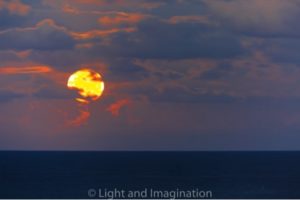
Focal length 400, f5.6, 5”, ISO 100 (on a tripod)
Remember sunrise / moonset and sunset / moonrise lag times can vary significantly from one day to the next so there will be many days when it is simply not possible to achieve these images because the sun will have set long before the moon rises, or risen well before the moon sets. Planning of locations is fundamental as well. You only have very few precious moments to see the moon rise or set, and, if there are clouds in the sky, the window of opportunity will be even shorter. So you need to be in the right place at the right time, with camera and tripod set and staring in the right direction!
Shooting the moon while it’s bright, big and high up in the sky is also a potentially rewarding task, and not as daunting an endeavor as some may think. Remember that the moon is much brighter than you imagine and much, much brighter than anything else in the night sky. If you are trying to shoot the moon well after sunset, then you must expose for the moon manually and ensure you compensate your exposure correctly or else you will just end up with a blurred white circle. Usually you need to set your shutter speed to a fast setting as the moon moves fairly quickly across the sky in an arc (also helps if you are shooting hand-held which is perfectly possible). Then pick an aperture to suit and ensure you get enough detail in the moon. All this is done in manual mode on the camera and if you’ve not attempted it before, there is nothing wrong with trial and error! It will help if you put the camera on a tripod and use live view so that you can see the detail in the moon’s surface.

Focal length 400mm, F8, 1/320, ISO 100 (handheld)
Things get trickier when you try to expose for the ambient as well as the moon once the sun had set so there is no more sunlight to illuminate the surroundings (we are talking here of non-urban environments). Then you need to get creative with your lighting and remember that only objects that are well illuminated will appear in the photo if you are also trying to expose correctly for the moon. In the instance below, once the sun had set we headed to the hilltops of Lanzarote’s Haria mountains to get a good vantage point over the sea, which was illuminated by the bright moon. While the moon was obviously illuminated by itself, the sea and the clouds were illuminated by the moon, and everything else was in relative darkness. We used our car lights to illuminate the top of the Martian-looking Lanzarote hilltops, used a relatively long exposure and further compensated for the brightness of the moon by using a graduated ND filter. The long exposure also gave us some nice cloud movement and smoothed out the sea water.

Focal length 90mm, f16, 20”, ISO 800 (on a tripod)
In an urban environment you benefit from street lights and other artificial lights which can be used to illuminate other elements you may want in your composition, as they will provide a relatively balanced exposure compared to the moon. In this example below we got a little creative with a minimalist composition including just the top of a lamppost and the moon, leaving everything else in darkness. In this scenario, one thing to be aware and mindful of is depth of field – while this is irrelevant when just shooting the moon, as soon as you add an object closer to the camera you need to adjust your f-number to ensure all desired elements are in focus.

Focal length 140, f16, 1/160, ISO 100 (handheld)
We have deliberately not specified what camera or lenses we used because people get far to hung up on talking about equipment – when settings such as the ones outlined in this blog post’s photos can be achieved with a large variety of equipment and lenses, and are brand-agnostic. We gave an indication of focal length rather than lens used as this can be achieved with different lenses and crop / full-frame cameras.
If you are interested in learning more about photography, check out our training courses available for all levels:
For Kent – www.lightandimagination.com
For London – www.photoion.co.uk
